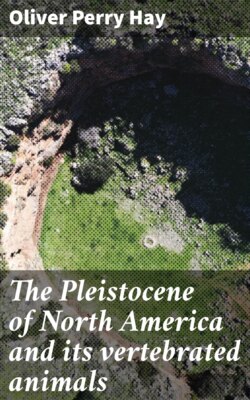Читать книгу The Pleistocene of North America and its vertebrated animals - Oliver Perry Hay - Страница 3
PREFACE.
ОглавлениеThe writer has been engaged for several years on an investigation of the Pleistocene geology of North America and of the Vertebrata which have been discovered in the deposits of this epoch. It had been his expectation to publish the results of all his studies at the same date. However, on consultation with Dr. John C. Merriam, it was agreed that it would be better to publish immediately that part which pertains to the region lying east of the Mississippi River and, as to the country further north, that east of longitude 95°.
At the outset the writer was convinced that, before just conclusions could be reached, it was necessary to know what fossil materials had been collected and under what geological and geographical conditions. He therefore made as thorough a search as possible of the literature for reports of discoveries of fossil vertebrates. Also, when in scientific journals or in newspapers the finding of fossils was recorded, recourse was had to correspondence, thus securing much exact information as to locality, kind of matrix, depth, and other important data. Often photographs have been obtained and even the materials themselves. The writer has also visited many museums and colleges throughout the country and examined their collections. Even in the smaller institutions, where perhaps only a few objects have been secured and preserved, some of these have furnished important information. Regret may be expressed that in the larger museums and colleges, as well as the smaller ones, too often there have been preserved only meager or no records regarding the history of what would otherwise be valuable specimens.
In order to show the geographical distribution of the most important species that occur in considerable numbers, a series of maps has been prepared, pertaining to the following:
Whales and porpoises.
Seals and walruses.
The edentates.
Elephas primigenius.
E. columbi.
E. imperator.
E. species undetermined.
Mastodons, mostly Mammut.
Horses, mostly Equus.
Tapirs.
Peccaries.
Camels.
Odocoileus.
Cervus.
Rangifer.
Musk-oxen.
Bisons, extinct.
Bison bison.
Giant beavers.
Where the map of a State has become too crowded with numerals, a special map of that State for that species or genus has been prepared. There are maps of the edentates in Florida; mastodons of Indiana, of New York, of Ohio, of Michigan, of Florida; Elephas columbi in Florida; Elephas imperator in Florida; horses in Florida.
Other maps and figures for illustration of the Pleistocene geology will be found in their proper places.
The first part of the present volume is occupied by a consideration of the specimens recorded on the maps. Such information is noted as could be secured, often satisfactory, little enough sometimes; but it has been found that one can not foresee what important information a given fossil may furnish. At least, the presence of the fossil at a locality indicates the existence there of Pleistocene deposits of some kind. In cases where other species have been associated with the one mapped and described, these are noted.
When the consideration of these mapped species and genera is completed, the Pleistocene geology of the various States and provinces is taken up, so far as it is related to the vertebrate palæontology. This involved an examination of much of the literature of the Glacial period; and here one soon finds himself in face of huge tomes and endless articles and detailed maps. Only somewhat less in amount is the literature of the States beyond the glaciated area. The opportunity to misunderstand and to commit errors is unlimited, and the writer can only hope for lenient criticism.
An attempt has been made in the case of all vertebrate fossils to determine their geological relations and to derive some general conclusions regarding the history of our Pleistocene vertebrates and their relation to the divisions of the Pleistocene epoch. The conclusions reached are embodied in the immediately succeeding pages.
Not much attention has been given to the fossil invertebrates and plants. It is evident that neither the mollusks nor the plants have undergone any considerable change during Pleistocene times and are therefore not available as indicators of geological stages, though often useful for determining local climatic conditions. Their value can be better utilized by the palæomalacologists and palæobotanists.
To the officers of museums and colleges and to the private individuals who have so freely offered the use of their materials and in other ways aided the writer, he takes pleasure in expressing his sincere thanks. Most of all, however, he is indebted to the Carnegie Institution of Washington for the generous support extended during the years of this investigation.
June 1, 1922.
Oliver P. Hay.
